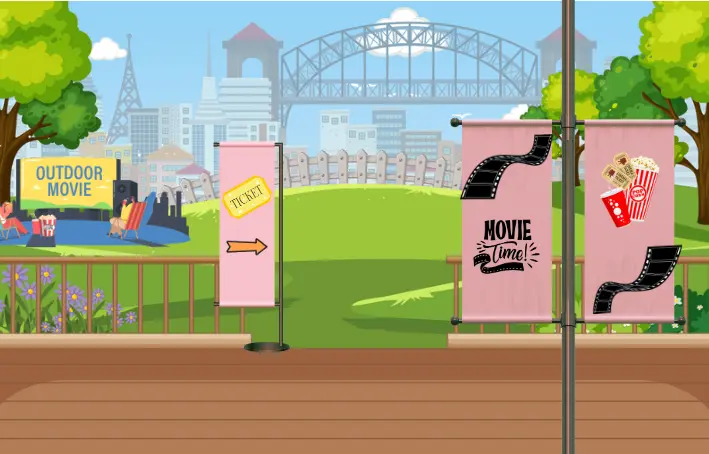Outdoor Signage Tips for Your Next Big Event
Posted by Arrowhead Signs & Displays on Dec 17th 2024
Outdoor signage plays a crucial role in the success of any big event, guiding attendees, promoting your brand, and creating memorable experiences. In this blog, we'll explore essential tips to ensure your signage hits the mark, both functionally and aesthetically.

Understanding the Purpose of Your Signage
Before creating your signage, it's essential to define its purpose. Whether it's directing attendees, promoting sponsors, or showcasing event activities, the purpose will guide the design and placement choices.
Determining the core objective of your signage can dramatically impact your event's flow and success. Clear directional signs can alleviate attendee confusion, while promotional banners can enhance sponsor visibility. The purpose should align with overall event goals, ensuring each sign serves a distinct function, be it informational or promotional. Taking the time to clearly define this will streamline the process of choosing designs and materials, ensuring that every piece of signage contributes effectively to your event’s narrative.
Choosing the Right Materials for Durability
Weather conditions can be unpredictable, so selecting materials that withstand the elements is key. Consider options like vinyl, Coroplast, or metal depending on the environment and anticipated weather.
Investing in durable materials is crucial for any outdoor event. Durable materials like vinyl and Coroplast not only stand up to harsh weather conditions but also maintain visual integrity over time, offering a cost-effective solution for longer events or those prone to unexpected weather changes. For permanent structures, metal might be more appropriate, offering robustness against wind and moisture while still allowing for vibrant, eye-catching designs. Evaluate your specific environmental challenges—rain, wind, or sun exposure—and choose materials that will present your branding optimally regardless of the weather conditions.
The consideration of reusability can also influence material choice. Opting for sustainable, long-lasting materials not only benefits the environment but can significantly reduce costs for future events. Recyclable materials or those that can be reshaped and resized offer exciting opportunities for creative redesigns and repeated functionality, ensuring that your investment continues to yield returns over time.
Designing for Visibility and Readability
Effective signage should be easily visible and legible from a distance. Use high-contrast colors, large fonts, and simple messaging to ensure attendees can quickly understand the information.
When designing outdoor signage, visuals are paramount. High contrast color schemes, such as dark text on a light background or vice versa, improve readability. Additionally, sans-serif fonts are generally easier to read from a distance and give a modern look, aligning with varied event themes. Simplicity in messaging ensures visitors aren't overwhelmed; concise information is more likely to be absorbed quickly and effectively. This approach enhances legibility even to those who might only catch a glimpse as they move through an event space.
Consider incorporating symbols or universally recognized icons alongside text to break language barriers and reinforce understanding. For instance, intuitive symbols like arrows for directions or event-specific icons can communicate a message efficiently, reducing reliance on textual language and appealing to a broader audience.
Strategic Placement for Maximum Impact
Placement is crucial to ensuring your signage catches the eye. Consider high-traffic areas and site lines that naturally draw attention to guide attendees efficiently and effectively.
To maximize the efficiency of your signage placement, think like an attendee. Walk through the event space and identify natural lines of sight and potential bottlenecks. Signage should be positioned along these lines to direct the flow of traffic effectively and reduce congestion points. Consider areas where attendees are likely to pause or gather, such as near restrooms, food stalls, or event entryways, to ensure key messages and branding are prominently displayed at these congregation points.
For longer events where attendees may need reminders throughout the day, periodic signage reinforcement can be beneficial. Consistently placed signs help reinforce messages and maintain navigational correctness.
Incorporating Technology for Enhanced Engagement
Consider integrating technology such as QR codes or digital displays to engage attendees in interactive experiences and provide real-time updates or information.
In today's digital age, incorporating technology into signage can significantly boost engagement and interaction. Digital displays offer dynamic content opportunities, from live event updates and schedule changes to real-time social media feeds. This adaptive approach keeps the audience informed and engaged with the event's evolving elements. QR codes offer a simple yet effective way to connect attendees to mobile apps or websites, providing additional details, promotions, or maps without overwhelming the physical signage with information.
Crafting Memorable Outdoor Signage for Event Success
By following these outdoor signage tips, you'll set the stage for a seamless and successful event. From design to placement, every aspect of your signage contributes to the overall experience. With effective signage, you can enhance visibility, communicate clearly, and leave a lasting impression on your attendees.


